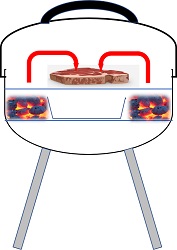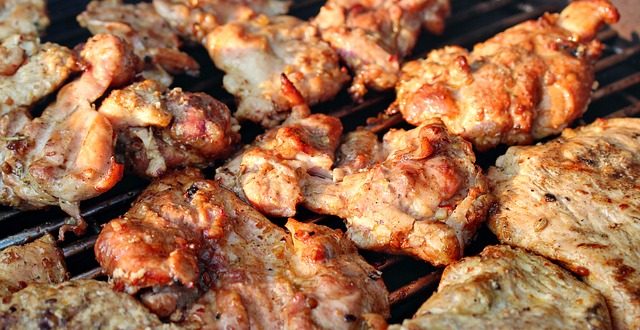Now that the weather has finally improved, here is our updated barbecue guide.
Barbecues are big business. Most garden centres will confront you with a range of grills and accessories across a broad price range. Disposable grills cost only a few pounds. High specification outdoor kitchen can cost as much as a family car. There is of course also the great barbecue divide, gas or charcoal; members of the latter camp (of which I admit to being one) tending to be the more vociferous of what is best. There is even a very active Facebook Group dedicated to Weber Charcoal grills.
Here then are my not completely unbiased tips to buying and using a barbecue:
Cooking method – Direct
Most budget and built in barbecues only allow this method. As the name indicates, food is placed directly above the heat. Direct cooking is fine for food that cooks fast but you need to be in continuous attendance. It will brown fast, burn easily and can cause flare ups as fat drips onto the heat. Unless you are careful; the classic bad BBQ experience of a burnt outside and raw inside will be the result, which can be dangerous!
Cooking method – Indirect

Weber pioneered indirect cooking as far as I know. It applies only to lidded barbecues such as their famous kettles.
The heat whether from gas or charcoal is at the sides, the food is placed in the middle, usually with a drip tray placed underneath. The cooking process is similar to using a conventional oven. The areas directly over the heat can still be used for browning or cooking thin cuts of meat, but it is essential to keep the lid on in order to retain heat and ensure everything is cooked through.
With the indirect method, you can cook joints of meat, whole chickens and if your BBQ is big enough, the Christmas turkey! As well as reducing dramatically the risk of giving your guests food poisoning, the great benefit of indirect cooking is that you can put the lid on, leave it and socialise.
A downside is that the grilling space is reduced so it is important to make sure you buy a barbecue big enough to feed your parties.
Ceramic bodied barbecues such as the Big Green Egg, being better insulated; use less charcoal and allow for longer, slower cooking without the need for charcoal top-ups. It seems they are the choice of many upmarket restaurants but attractive as they look, price wise they are beyond me!
Gas, Electric or Charcoal Barbecues

The big benefit of gas is convenience, it lights quickly and there is no ash to remove afterwards. Electric models are convenient but they are less suitable for entertaining due to their limited power. If you live in a flat and are fortunate to have a balcony, an electric barbecue is the safest option, although restrictions on use may still apply.
Charcoal purists will argue that the natural smoke gives better flavour to the food. Gas advocates will suggest adding wood chips for flavour (you can use them with charcoal for extra flavour). With gas, make sure indirect cooking is possible. Normally achieved by not using the centre burner.
The simple invention of the chimney starter eliminated charcoal’s biggest disadvantage. Lighting could be hit and miss, now it is foolproof. You simply measure your charcoal into the chimney, place it over a couple of lit firelighters. When the coals at the top of the chimney have white edges after about 15-20 minutes you can carefully pour them into the grill. I then place the lid on for about ten minutes before starting cooking, giving just enough time for that first drink.
Many of the cheaper charcoal models are open grills and so are unsuitable for indirect cooking. I would only consider a closed design, in my opinion this approach also retains the smoky flavours. Always look for a model where the base can open to remove the ash easily.
Barbecue Accessories and Fuel
 It is essential to have some long handled tongs, these should not be flimsy, it would be a disaster to drop your food on the ground. An insulated glove is also useful, essential when you use a chimney starter. Other useful items are a silicone basting brush, a long handled roasting fork and fish slice. If you are regularly cooking fish, dedicated fish baskets are useful. A digital thermometer is used to ensure food is thoroughly cooked before serving.
It is essential to have some long handled tongs, these should not be flimsy, it would be a disaster to drop your food on the ground. An insulated glove is also useful, essential when you use a chimney starter. Other useful items are a silicone basting brush, a long handled roasting fork and fish slice. If you are regularly cooking fish, dedicated fish baskets are useful. A digital thermometer is used to ensure food is thoroughly cooked before serving.
It’s wise to have a table or shelf adjacent to the barbecue, make sure it’s stable.
Clean the grill after cooking with a grill wire-brush. I like the V shaped designs allowing you to get between the individual grill strips, I then wipe the grill down with kitchen paper.
If you do go for gas, it’s worth having a spare gas bottle, it could be disaster if you one bottle runs out half way through your party.
For charcoal there is a choice of lumpwood or briquettes. Purists prefer the former, as there are no additives (binders), I though, have found lumpwood burns through too quickly with my Weber kettle. Like most things, quality varies, cheaper charcoal can contain a lot of dust and small lumps which burn through too fast.
General Points

Outdoor cooking seems to improve appetites so you need to cook enough food for the size of your typical families or parties. To do this you will need enough grill space, cooking indirect does reduce the space available, but by using or buying warming grills alleviate this, allowing you to cook slowly or keep things warm.
Make sure everything is cooked thoroughly, digital thermometers are widely available.
Quality of build and finish vary enormously and with size influence the price. The well-known brands cost more, but they are built to last and the grills are more resistant to corrosion. If you invest in a more expensive model also buy a good quality protective cover.
Never use a barbecue in a confined space due to the risk of carbon monoxide poisoning.
My choice
 My original Weber Kettle is now over 25 years old, is now with our son and still working fine. I now have a new apple green model.
My original Weber Kettle is now over 25 years old, is now with our son and still working fine. I now have a new apple green model.
Over the years I have bought many accessories, warming grills (to add space), charcoal holders, fish baskets and a working table, that seems to be part of the fun. It is a design classic but it also works extremely well.
 Gardeners Club The Gardeners Club is a free to join online club for everyone with an interest in gardening and gardens.
Gardeners Club The Gardeners Club is a free to join online club for everyone with an interest in gardening and gardens.






